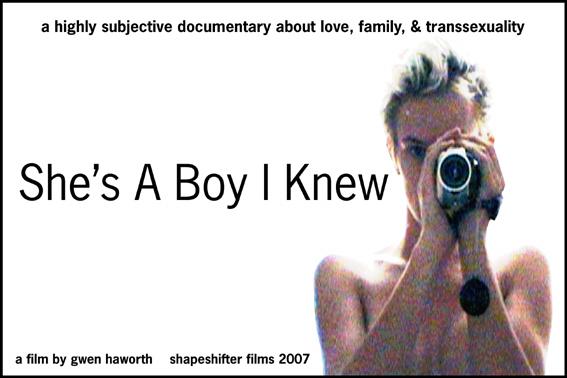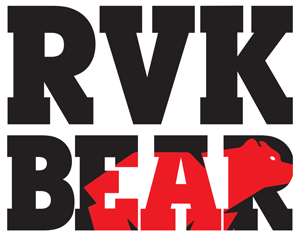Gwen Haworth the canadian filmmaker is premiering her film She's a Boy I Knew at the Reykjavik Queer Film Festival on Saturday 27. september 2008. This is an intimate and personal description of her transition from male to female (MTF) where she turns turns the camera on herself and gets her family and friends to express themselfes on this. Anna Jonna Ármannsdóttir interviewed Gwen and felt this was a superb opportunity to write from the transgender point of view. Each interview depends on both the interviewer and the person interviewed so she got a short description of me and my transition and thereby the most important thing, that she was being interviewed by a transwoman that by the way is interested in gender theory.
Anna: You have probably seen a lot of films, shows, sketches, where supposedly transpersons appear. What is Your opinion of some of those characters in terms of stereotypes, and normativity?
Haworth: It’s amazing to me that many filmmakers think they are making innovative films when they show transgender people being victimized and disempowered. What they fail to realize is that their film has already been made countless times before, just with a slightly different twist. Most of these filmmakers are not transgender or queer, so they are usually unaware of the multitude of disempowering representations that already exist, and that negatively impact the transgender community’s self-worth and how the rest of society perceives us.
Anna: Please give a few examples of realistic traits in fictional trans-characters.
Haworth: It’s an old film but I really like the transwomen played by John Lithgow in The World According To Garp. Lithgow plays a trans women who is tall, broad shouldered, and used to be a football player. What I really like about this character is that she has found peace with herself, she’s open about who she is, and allows all of her feminine and masculine traits to flourish, regardless of her gender identity. I think this is something both trans and non-trans folk can learn a lot from.
Anna: The public opinion of trans-people, our life, hopes and dreams, has improved a lot the last few decades. Is there still room for improvement in the public opinion?
Haworth: Absolutely. To this day, most people have never seen a representation of transgender individual in film or television that was actually made by a transgender filmmaker! I firmly believe that self-representation is an important component for self-empowerment, so until we start seeing some films that are produced, written, and directed by transgender filmmakers in the mainstream media, I think our community stills has a long way to go in order to help change public opinion.
Anna: Is it human nature, to throw away redundant information and simplify personal relations, until everything fits predefined ideas? And how do we react when we are forced to find new ideas for describing our relationship to somebody else? I know this one is far out philosophical so you may choose not to answer it :)
 Haworth: Certain communities, especially those that use fear as a tactic for maintaining order, definitely have a tendency to oversimplify or outcast anyone who is perceived as different from their ideal citizen. When it comes to transgender folk, the stereotypes that I see of trans women in the North American media are still incredibly limiting and archaic. Arguably worse, trans men (female-to-male) are still almost non-existent in the mainstream media. Look at the current barrage of films about transsexuals in the Middle East & Asia that are being made by North American & European filmmakers. You’ll notice the filmmakers (usually not transgender or queer) are still consciously deciding to document trans women & not trans men, because the women fit the filmmakers preconceived ideas about transsexuals as disempowered victims and outcasts who are forced to work in the sex trade.
Haworth: Certain communities, especially those that use fear as a tactic for maintaining order, definitely have a tendency to oversimplify or outcast anyone who is perceived as different from their ideal citizen. When it comes to transgender folk, the stereotypes that I see of trans women in the North American media are still incredibly limiting and archaic. Arguably worse, trans men (female-to-male) are still almost non-existent in the mainstream media. Look at the current barrage of films about transsexuals in the Middle East & Asia that are being made by North American & European filmmakers. You’ll notice the filmmakers (usually not transgender or queer) are still consciously deciding to document trans women & not trans men, because the women fit the filmmakers preconceived ideas about transsexuals as disempowered victims and outcasts who are forced to work in the sex trade.
Recently, I watched an interview by a filmmaker where she admits that when shooting in Iran, she decided not to continue filming the individuals transitioning from female-to-male (FTM) because they were not as “interesting” to her as the male-to-females (MTF). She decided that because the FTMs’ families and society accepted them much easier, that they were less engaging for her film than the disempowered and angst-ridden MTFs. I find it appalling when filmmakers deliberately chose not to include the more positive trans stories, in order to focus on the stereotypical negative stories. I truly believe filmmakers like this are perpetuating the discrimination that the transgender community faces, whether the filmmaker is perceptive enough to realize it or not.
Anna: I personally know many transwomen who have gone through many different kinds of crisis with their families, when dealing with the changes in interpersonal relationships. Some of the reactions are rejection and grief. After some time there is often a change in the reaction. This is probably in Your film describing your personal experience. Do you know other transwomen that have experienced this?
Haworth: I know many transwomen & men who have maintained relationships with their families. There is usually a period of time when there is some family struggle to renegotiate these relationships, but unlike what is often portrayed in the media, many families do make it through this period.
That’s why I made my film. There are almost no films out there that are made specifically for the family and friends of transgender people. When the only images our families see are negative portrayals, it’s understandable why it is so hard for many of them to be supportive. Therefore, I felt it was incredibly important to show the storey of my family, how we initially struggled, but ultimately came to love and appreciate each other more than we had before.
Anna: The stereotypical film has a manuscript, actors and predefined set of surroundings to make the film. As a film director how did you plan your film? How do you cope with the unpredictability of making a film like this? Was it possible to use retakes or just film from different angles?
Haworth: When developing a documentary, you often have a hypothesis about how the story may evolve. However, once production begins, you need to let go of all presumptions and document the real story as it unfolds. I initially thought She’s a Boy I Knew would be more experimental, but after shooting the interviews with my family, I realized the film would need to become a documentary in order to truly respect the honest and vulnerable answers that my family gave to me. And after three years of editing, the film has definitely evolved in ways I would not have initially foreseen. However, from the beginning, I knew the theme of the film would be ‘Family’ and after shooting the interviews, I felt pretty confident that I had the material to make a trans documentary that stood out from the others.
Anna: Any thing you would like to add?
Haworth: I really want to encourage others to get out there and tell their own stories, instead of letting the “professional” filmmaker do it for them. We need more first-person stories made by people from within their communities. She’s a Boy I Knew was a do-it-yourself film that I made with consumer grade cameras and no funding. It’s doing remarkably well on the international scene, because it is an innovative and proactive autobiography that creates empathy and understanding in a way that no filmmaker from outside the transgender community could ever capture. I truly believe that if we are ever to get past the mainstream media’s imposed culture of fear, we are going to need diverse communities to make their own representations that help us to understand and have compassion for one another.
Interview: Anna Jonna Ármannsdóttir
RIFF Interview with Gwen Haworth
Filmmaker of She's a Boy I Knew
www.artflick.com, This email address is being protected from spambots. You need JavaScript enabled to view it.


